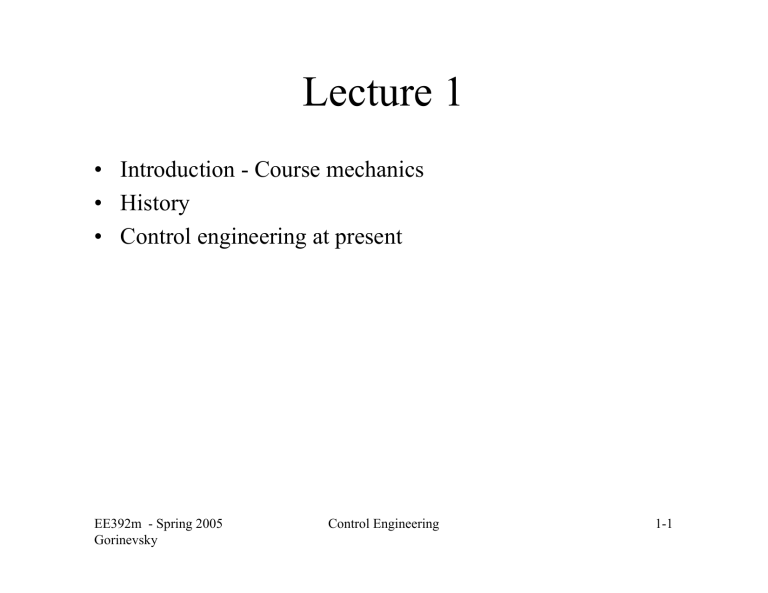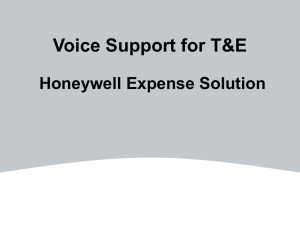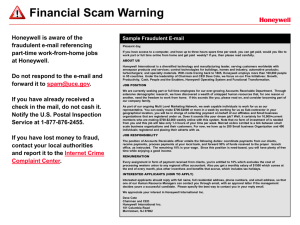
Lecture 1
• Introduction - Course mechanics
• History
• Control engineering at present
EE392m - Spring 2005
Gorinevsky
Control Engineering
1-1
Introduction - Course Mechanics
•
•
•
•
•
What this course is about?
Prerequisites & course place in the curriculum
Course mechanics
Outline and topics
Your instructor
EE392m - Spring 2005
Gorinevsky
Control Engineering
1-2
What this course is about?
• Embedded computing is becoming ubiquitous
• Need to process sensor data and influence physical world.
This is control and knowing its main concepts is important.
• Much of control theory is esoteric and difficult
• 90% of the real world applications are based on 10% of the
existing control methods and theory
• The course is about these 10%
– Focus on a few methods used in majority of the applications
– Some methods are familiar from E105, EE205; actual application
of these methods is the key in this course
– Some material is not covered in other courses
EE392m - Spring 2005
Gorinevsky
Control Engineering
1-3
Course Focus and Name
• Academic research
–
–
–
–
Quest for knowledge
What else can we say about this topic
Mathematical theory
Many controls books and papers
• This course
– Oriented towards engineering practices in industry
– What is the minimal knowledge/skills we need to solve an
engineering problem?
– What are the engineering problems?
– What methods do engineers actually use in industry?
– Additional knowledge sure helps…
EE392m - Spring 2005
Gorinevsky
Control Engineering
1-4
Prerequisites and course place
• Prerequisites:
– Linear algebra: EE263, Math 103
– Systems and control basics: EE102, ENGR 105, ENGR 205
• Helpful
–
–
–
–
–
Matlab
Modeling and simulation
Optimization
Application fields
Some control theory good, but not assumed.
• Learn more advanced control theory:
– In ENGR 207, ENGR 209, and ENGR 210
– Needed for high-performance applications
EE392m - Spring 2005
Gorinevsky
Control Engineering
1-5
Course Mechanics
•
•
Descriptive in addition to math and theory. Skills and attitude.
Grading (the weights are approximate)
– 35% Homework Assignments (3 at all)
– 30% Midterm Project
– 35% Final Project
•
Notes at www.stanford.edu/class/ee392M/
– Posted as available
– 2003 version available, the 2005 version has less coverage and more depth
•
Reference texts
– Analysis and Design of Feedback Systems, Åström and Murray, 2003.
http://www.cds.caltech.edu/~murray/courses/cds101/fa03/caltech/am03.html
– Feedback Control of Dynamic Systems, Fourth Edition, Franklin, Powell,
Emami-Naeini, Prentice Hall, 2002
– Control System Design, Goodwin, Graebe, Salgado, Prentice Hall, 2001
EE392m - Spring 2005
Gorinevsky
Control Engineering
1-6
Outline and topics
Lectures - Mondays & Wednesday
Assignments - due in a week
2:30-3:45pm
Lecture 6 Outer Loop
Lecture 7 SISO Analysis
Lecture 8 SISO Design
EE392m - Spring 2005
Gorinevsky
Additional
topics
SISO
Control
Basic
Lecture 1 Introduction
Lecture 2 Linear Systems
Lecture 3 Basic Feedback
Lecture 4 PID
Lecture 5 Digital Control
Lecture 9 Modeling & Simulation
Lecture 10 Identification
Lecture 11 Internal Model Control
Advanced Control
Lecture topics
Lecture 12 Optimization
Lecture 13 Programmed Control
Lecture 14 Model Predictive
Control
Lecture 15 System Health
Management
Control Engineering
1-7
Assignment timeline
Assignment 1
Assignment 2
Midterm
Assignment 3
Final
EE392m - Spring 2005
Gorinevsky
Lecture 1 Introduction
Lecture 2 Linear Systems
Lecture 3 Basic Feedback
Lecture 4 PID
Lecture 5 Digital Control
Lecture 6 Outer Loop
Lecture 7 SISO Analysis
Lecture 8 SISO Design
Lecture 9 Modeling & Simulation
Lecture 10 Identification
Lecture 11 Internal Model Control
Lecture 12 Optimization
Lecture 13 Programmed Control
Lecture 14 Model Predictive Control
Lecture 15 System Health Management
• Final presentation
Control Engineering
1-8
Who is your instructor?
• Consulting Professor of EE
• Honeywell Labs
– Minneapolis, MN
– San Jose, CA
• Worked on decision and control systems applications
across many industries
• PhD from Moscow University
– Moscow → Munich → Toronto → Vancouver → Palo Alto
EE392m - Spring 2005
Gorinevsky
Control Engineering
1-9
Lecture 1 - Control History
• Watt’s governor
• Thermostat
• Feedback Amplifier
• Missile range control
• DCS
• TCP/IP
=======================
• Current trends
• Control application areas
EE392m - Spring 2005
Gorinevsky
Control Engineering
1-10
Why bother about the history?
• Trying to guess, where the trend goes
• Many of the control techniques that are talked about are
there for historical reasons mostly. Need to understand
that.
EE392m - Spring 2005
Gorinevsky
Control Engineering
1-11
1788 Watt’s Flyball Governor
• Watt’s Steam Engine
• Newcomen’s steam engine (1712)
was a limited success
• Beginning of systems engineering
• Watt’s systems engineering add-on
started the Industrial Revolution
• Analysis of James Clark Maxwell
(1868)
• Vyshnegradsky (1877)
From the 1832 Edinburgh Encyclopaedia
EE392m - Spring 2005
Gorinevsky
Control Engineering
1-12
Main Points
• Mechanical technology use was extended from
power to regulation
• It worked and improved reliability of steam engines
significantly by automating operator’s function
• Analysis was done much later (some 100 years).
This seems to be typical!
• Parallel discovery of major theoretical approaches
EE392m - Spring 2005
Gorinevsky
Control Engineering
1-13
Watt’s governor
• Analysis of James Clark Maxwell (1868)
(
mlφ&& = l mωG2 l sin φ cos φ − mg sin φ − bφ&
Jω& E = k cos φ − TL
ωG = nω E
• Linearization
φ = φ0 + x
ω E = ω0 + y
x << 1
y << 1
&y&& + a1 &y& + a2 y& + a3 y = 0
EE392m - Spring 2005
Gorinevsky
Control Engineering
1-14
)
Watt’s governor
&y&& + a1 &y& + a2 y& + a3 y = 0
Characteristic equation:
λ3 + a1λ2 + a2λ + a3 = 0
y=e
λt
Im λ
Stability condition:
Re λk < 0, ( k = 1,2,3)
• Main points:
–
–
–
–
Re λ
Modeling
P feedback control
Linearization
LHP poles
• All still valid
EE392m - Spring 2005
Gorinevsky
Control Engineering
1-15
1885 Thermostat
• 1885 Al Butz invented damper-flapper
– bimetal plate (sensor/control)
– motor to move the furnace damper)
• Started a company that became
Honeywell in 1927
• Thermostat switching on makes the main motor shaft to
turn one-half revolution opening the furnace's air damper.
• Thermostat switching off makes the motor to turn another
half revolution, closing the damper and damping the fire.
• On-off control based on threshold
EE392m - Spring 2005
Gorinevsky
Control Engineering
1-16
Main Points
• Use of emerging electrical system technology
• Significant market for heating regulation (especially in
Minnesota and Wisconsin)
• Increased comfort and fuel savings passed to the customer.
Customer value proposition
• Integrated control device with an actuator. Add-on device
installed with existing heating systems
EE392m - Spring 2005
Gorinevsky
Control Engineering
1-17
1930s Feedback Amplifier
• Signal amplification in first telecom systems (telephone)
Analog vacuum tube amplifier technology
• Feedback concept
V1 − V V − V2
=
R1
R2
V2 = GV
⎡1 1⎛1
V1
1 ⎞⎤
R1 ⎡ 1 ⎛
R2 ⎞⎤
= R1 ⎢ − ⎜⎜ + ⎟⎟⎥ = − ⎢1 − ⎜⎜1 + ⎟⎟⎥
V2
R2 ⎣ G ⎝
R1 ⎠⎦
⎣ R2 G ⎝ R1 R2 ⎠⎦
• Bode’s analysis of the transients in the amplifiers (1940)
EE392m - Spring 2005
Gorinevsky
Control Engineering
1-18
Feedback Amplifier - Main Points
• Electronic systems technology
• Large telecommunications market
• Useful properties of large gain feedback realized:
linearization, error insensitivity
• Conceptual step. It was initially unclear why the feedback
loop would work dynamically, why it would not always
grow unstable.
EE392m - Spring 2005
Gorinevsky
Control Engineering
1-19
1940s WWII Military Applications
• Sperry Gyroscope Company – flight instruments – later
bought by Honeywell to become Honeywell aerospace
control business.
• Servosystem – gun pointing, ship steering, using gyro
• Norden bombsight – Honeywell C-1 autopilot - over
110,000 manufactured.
• Concepts – electromechanical feedback, PID control.
• Nyquist, servomechanism, transfer function analysis,
EE392m - Spring 2005
Gorinevsky
Control Engineering
1-20
Autopilot - Main Points
• Enabled by the navigation technology - Sperry gyro
• Honeywell got the autopilot contract because of its
control system expertise – in thermostats
• Emergence of cross-application control engineering
technology and control business specialization.
EE392m - Spring 2005
Gorinevsky
Control Engineering
1-21
1960s - Rocket science
• SS-7 missile range control
– through the main engine cutoff time.
• Range
r = F (∆Vx , ∆V y , ∆X , ∆Y )
• Range Error
USSR R-16/8K64/SS-7/Saddler
Copyright © 2001 RussianSpaceWeb.com
http://www.russianspaceweb.com/r16.html
δr (t ) = f1∆Vx (t ) + f 2 ∆V y (t ) + f 3∆X (t ) + f 4 ∆Y (t )
• Algorithm:
– track δr (t ) , cut the engine off at T when δr (T ) = 0
EE392m - Spring 2005
Gorinevsky
Control Engineering
1-22
Missile range control - Main Points
• Nominal trajectory needs to be pre-computed and optimized
• Need to have an accurate inertial navigation system to
estimate the speed and coordinates
• Need to have feedback control that keeps the missile close to
the nominal trajectory (guidance and flight control system)
• f1, f2, f3, f4, and fT must be pre-computed
• Need to have an on-board device continuously computing
δr (t ) = f1∆Vx (t ) + f 2 ∆V y (t ) + f 3∆X (t ) + f 4 ∆Y (t )
EE392m - Spring 2005
Gorinevsky
Control Engineering
1-23
1975 - Distributed Control System
• 1963 - Direct digital control was introduced at a
petrochemical plant (Texaco)
• 1970 - PLC's were introduced on the market.
• 1975 - First DCS was introduced by Honeywell
• PID control, flexible software
• Networked control system, configuration tuning and access
from one UI station
• Auto-tuning technology
EE392m - Spring 2005
Gorinevsky
Control Engineering
1-24
DCS
example
Honeywell
Experion PKS
Honeywell Plantscape
SCADA = Supervisory Control And Data Acquisition
EE392m - Spring 2005
Gorinevsky
Control Engineering
1-25
DCS - Main Points
•
•
•
•
Digital technology + networking
Rapid pace of the process industry automation
The same PID control algorithms
Deployment, support and maintenance cost reduction for
massive amount of loops
• Auto-tuning technology
• Industrial digital control is becoming a commodity
• Facilitates deployment of supervisory control and monitoring
EE392m - Spring 2005
Gorinevsky
Control Engineering
1-26
1974 - TCP/IP
• TCP/IP - Cerf/Kahn, 1974
• Berkeley-LLNL network
crash, 1984
• Congestion control -Van
Jacobson, 1986
EE392m - Spring 2005
Gorinevsky
Control Engineering
1-27
TCP flow control
Round Trip Time
Source
1 2
W
1 2
W
time
ACK
data
Destination
τ
1 2
W
1 2
W
time
Transmission rate: x = W packets/sec
τ
Here:
• Flow control dynamics near the maximal transmission rate
• From S.Low, F.Paganini, J.Doyle, CSM, 2000
EE392m - Spring 2005
Gorinevsky
Control Engineering
1-28
TCP Reno congestion avoidance
• packet acknowledgment rate: x
• lost packets: with probability q
∆xlost = − xW / 2
for every loss {
W = W/2
}
for every ACK {
W += 1/W
}
x& = q
x& =
EE392m - Spring 2005
Gorinevsky
• transmitted: with probability (1-q)
∆xsent = x / W
∆xlost
τ
1− q
τ2
+ (1 − q )
1 2
− qx
2
∆xsent
τ
•
•
•
Control Engineering
x=
W
τ
x - transmission rate
τ - round trip time
q - loss probability
1-29
TCP flow control - Main Points
•
•
•
•
Flow control enables stable operation of the Internet
Developed by CS folks - no ‘controls’ analysis
Ubiquitous, TCP stack is on ‘every’ piece of silicon
Analysis and systematic design is being developed some
20 years later
• The behavior of the network is important. We looked at a
single transmission link.
• Most of analysis and systematic design activity are
happening in the last 5-6 years and this is not over yet ...
EE392m - Spring 2005
Gorinevsky
Control Engineering
1-30
Past Æ Present
• That was history
• What is going on in control at present?
EE392m - Spring 2005
Gorinevsky
Control Engineering
1-31
Control Engineering at Present
Controls people could ask:
• What big control application is coming next?
• Where and how control technology will be used?
Other engineers could ask:
• What do we need to know about controls to get by?
Will discuss in this course, along with some systems
engineering ideas
EE392m - Spring 2005
Gorinevsky
Control Engineering
1-32
Focus of This Course
Measurement
system,
sensors
Control
computing
Control
handles,
actuators
Physical system
• This course is focused on control computing algorithms
and their relationship with the overall system design.
• System engineering (design and analysis) is closely related
to control computing analysis
EE392m - Spring 2005
Gorinevsky
Control Engineering
1-33
Technology Trends
• Why this is relevant and important at present?
• Computing is becoming ubiquitous
• Sensors are becoming miniaturized, cheap, and pervasive.
MEMS sensors
• Actuator technology developments include:
–
–
–
–
evolution of existing types
previously hidden in the system, not actively controlled
micro-actuators (piezo, MEMS)
control handles other than mechanical actuators, e.g., in telecom
EE392m - Spring 2005
Gorinevsky
Control Engineering
1-34
Measurement system evolution.
Navigation system example
•Mechanical gyro by Sperry – for ships,
aircraft. Honeywell acquired Sperry
Aerospace in 1986 - avionics, space.
• Laser ring gyro, used in
aerospace presently.
• MEMS gyro – good for any
vehicle/mobile appliance.
– (1") 3 integrated navigation unit
EE392m - Spring 2005
Gorinevsky
Control Engineering
1-35
Actuator evolution
• Electromechanical actuators: car power everything
• Communication - digital PLL
• Adaptive optics, MEMS
control
handle
EE392m - Spring 2005
Gorinevsky
Control Engineering
1-36
Control computing
• Computing grows much faster than the sensors and actuators
• CAD tools, such as Matlab/Simulink, allow focusing on
algorithm design. Implementation is automated
• Past: control was done by dedicated and highly specialized
experts. Still the case for some very advanced systems in
aerospace, military, automotive, etc.
• Present: control and signal-processing technology are
standard technologies associated with computing.
• Embedded systems are often designed by system/software
engineers.
• This course emphasizes practically important issues of
control computing
EE392m - Spring 2005
Gorinevsky
Control Engineering
1-37
Control and Systems Engineering
•
•
•
•
Computing element - software
System, actuator, and sensor physics might be very different
Modeling abstraction
Controls and systems engineering are used across many
applications
– similar principles
– transferable skills
– mind the application!
EE392m - Spring 2005
Gorinevsky
Control Engineering
1-38
Practical Issues of Control Design
• Technical requirements
• Economics: value added, # of replications
– automotive, telecom, disk drives - millions of copies produced
– space, aviation - unique to dozens to several hundreds
– process control - each process is unique, hundreds of the same type
•
•
•
•
•
•
Developer interests, cool factor
Integration with existing system features
Skill set in engineering development and support
Field service/support requirements
Marketing/competition, creation of unique IP
Regulation/certification: FAA/FDA
EE392m - Spring 2005
Gorinevsky
Control Engineering
1-39
Major control applications
Specialized control groups, formal development processes
• Aviation
– Guidance, Navigation, and Control (GN&C)
– propulsion - engines
– vehicle utilities: power, environmental control, etc
• Automotive
– powertrain
– suspension, traction, braking, steering
• Disk drives
• Industrial automation and process control
– process industries: refineries, pulp and paper, chemical
– semiconductor manufacturing processes
– home and buildings
EE392m - Spring 2005
Gorinevsky
Control Engineering
1-40
Commercial applications
Advanced design - commercial
• Embedded mechanical
– mechatronics/servo actuators
• Robotics
– lab automation
– manufacturing plant robots (e.g., automotive)
– semiconductors
• Power
– generation and transmission
• Transportation
– locomotives, elevators
– marine
• Nuclear engineering
EE392m - Spring 2005
Gorinevsky
Control Engineering
1-41
High-performance applications
Advanced design
• Aerospace and Defense
–
–
–
–
–
aero, ground, space vehicles - piloted and unmanned
missiles/munitions
comm and radar: ground, aero, space
campaign control: C4ISR
directed energy
• Science instruments
– astronomy
– accelerators
– fusion: TOKAMAKs, LLNL ignition
EE392m - Spring 2005
Gorinevsky
Control Engineering
1-42
Embedded applications
No specialized control groups
• Embedded controllers
–
–
–
–
consumer
test and measurement
power/current
thermal control
• Telecom
–
–
–
–
PLLs, equalizers
antennas, wireless, las comm
flow/congestion control
optical networks - analog, physics
EE392m - Spring 2005
Gorinevsky
Control Engineering
1-43
Emerging control applications
A few selected cases
• Biomedical
–
–
–
–
–
life support: pacemakers anesthesia
diagnostics: MRI scanners, etc
ophthalmology
bio-informatics equipment
robotics surgery
• Computing
– task/load balancing
• Finance and economics
– trading
EE392m - Spring 2005
Gorinevsky
Control Engineering
1-44

